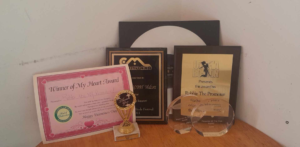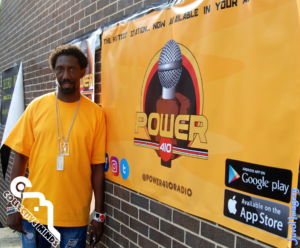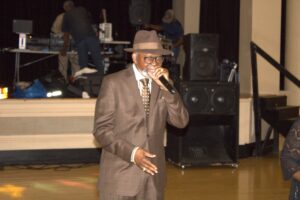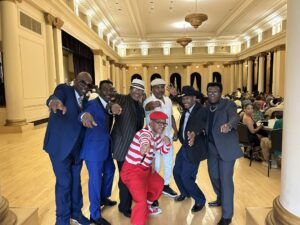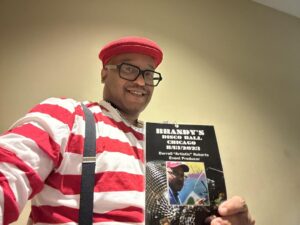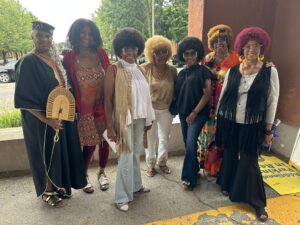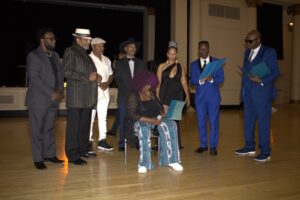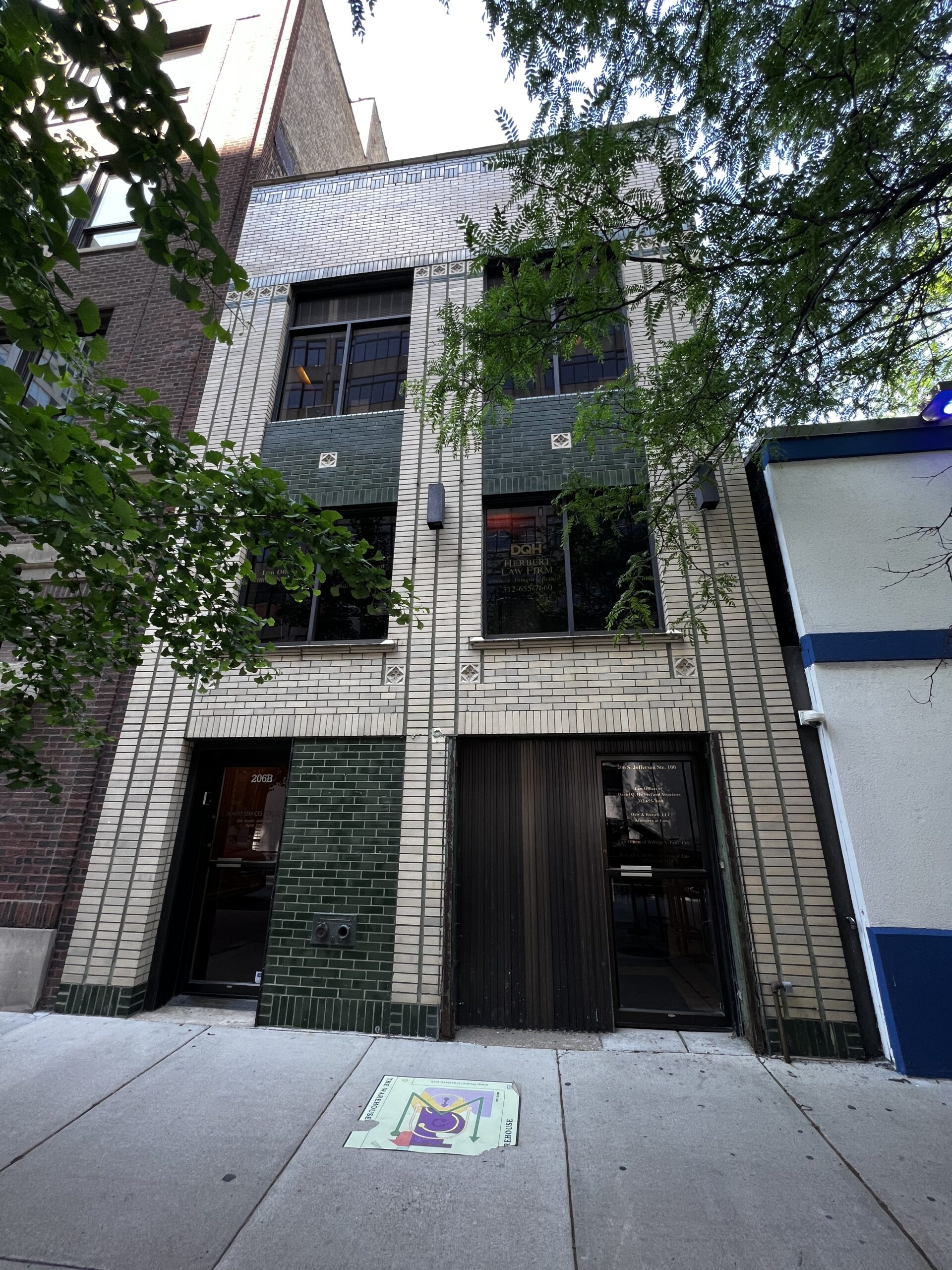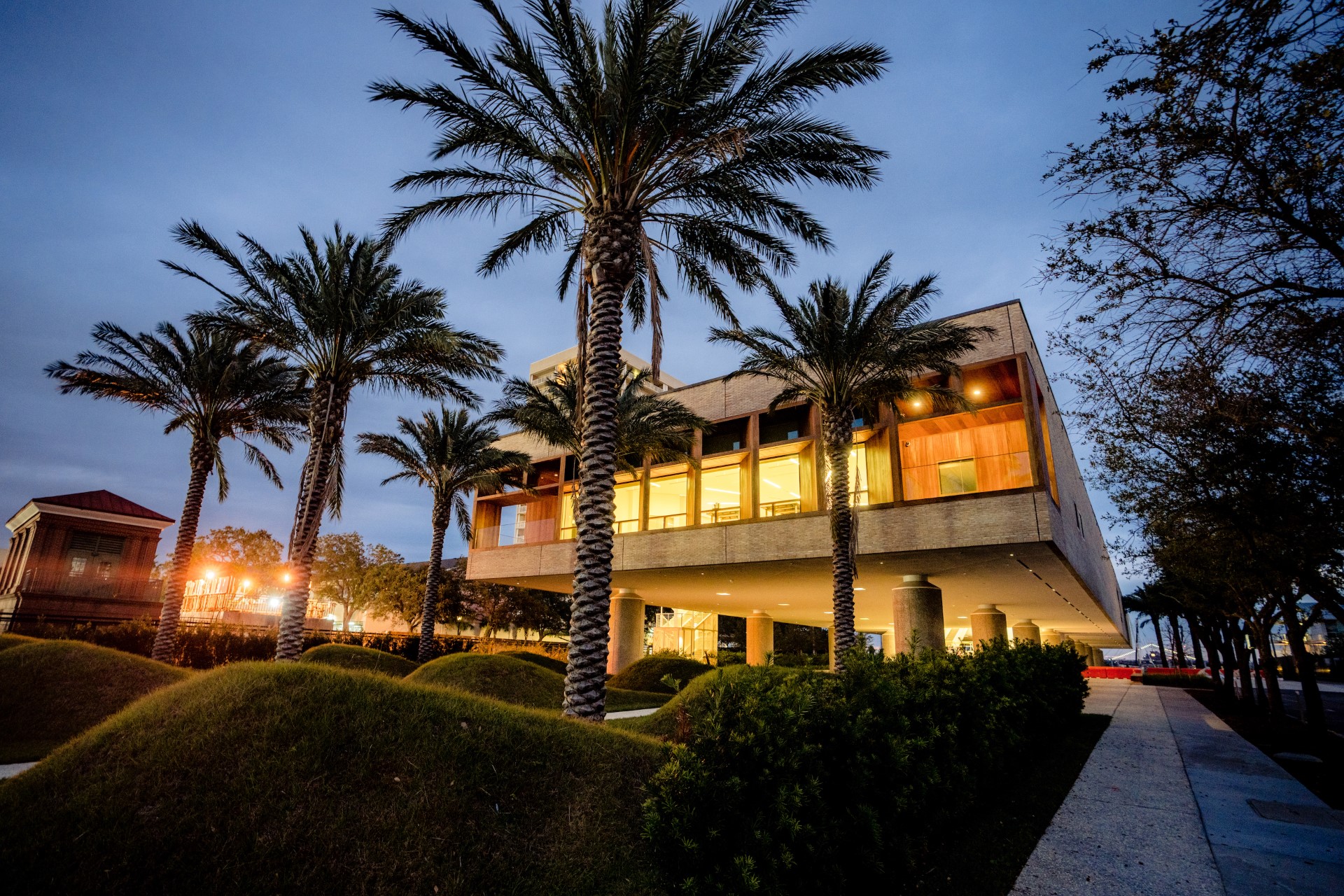The International African American Museum (IAAM) explores the history, culture, and impact of the African American journey on Charleston, on the nation, and on the world, shining light and sharing stories of the diverse journeys, origin, and achievements of descendants of the African Diaspora. Located in Charleston, S.C., at the historically sacred site of Gadsden’s Wharf, IAAM honors the untold stories of the African American journey.
Across 9 galleries and a memorial garden with art, objects, artifacts, and multi-media interaction, IAAM is a champion of authentic, empathetic storytelling of American history. As a result, the museum will stand as one of the nation’s newest platforms for the disruption of institutionalized racism as it evolves today. The mission of IAAM is to honor the untold stories of the African American journey at the historically sacred site of Gadsden’s Wharf and beyond.
Its nine distinct galleries will demonstrate how enslaved Africans and free blacks shaped economic, political, and cultural development throughout the nation and beyond, while offering an especially close look at the connection to the South Carolina Lowcountry. These include the Transatlantic Experience, the Atlantic Worlds Gallery, the South Carolina Connections Gallery, the Gullah Geechee Gallery, the American Journeys Gallery, the Carolina Gold Gallery, the
African Roots Gallery, The Theater, and the Special Exhibitions Gallery.
In addition to the galleries, the African Ancestors Memorial Garden sprawls across the museum’s grounds and reflects on the historic significance of Gadsden’s Wharf, one of the many docks in Charleston Harbor at which an estimated 45% of enslaved Africans entered this country. Artistic installations and site objects mark the history and archeology there. This area, which will be free and open to the public, also provides a space for informal and structured gatherings where stories and traditions can once again be shared.
Working to serve and improve equity for Black and African Americans, IAAM is a champion of authentic, empathetic storytelling of American history and is thus one of the nation’s newest platforms for the disruption of institutionalized racism as it evolves today.
Opening on June 27 of 2023, IAAM has been in the works since 2000 when former Charleston Mayor Joseph P. Riley, Jr., voiced a need for the museum in his State of the City address. In 2002, a steering committee was formed to explore the development of the museum, and in 2005, Congressman Jim Clyburn became the museum’s first chair of the Board of Directors. As of early 2022, IAAM had raised close to $100 million dollars toward building construction and the foundation of what will comprise the heart of the museum. Since 2021, Dr. Tonya M. Matthews, president and chief executive officer of IAAM, has guided the extensive efforts leading to the museum’s opening and its ongoing efforts to tell the story of the African American journey.
The African Ancestors Memorial Garden, a collection of gardens and artistic installations that sprawls across the IAAM grounds, will be free and open to the public. It will give visitors the opportunity to honor African ancestors and reflect on the historic significance of Gadsden’s Wharf facing the harbor, where some historians estimate more than 45% of enslaved Africans entered this country. Site objects mark the history and archeology there. This area also allows for
informal and programmed gatherings where stories and traditions can once again be shared.
Technology and Educational Features for Visitors:
• Another centerpiece of the museum, the “Atlantic Worlds Gallery,” will be furnished with North America’s first public installation of the latest Crystal LED display in a 32-
foot wide, 7-foot-high configuration provided by Sony. The immersive audio/visual experience is expected to elicit a powerful emotional response from visitors, as it brings
history to life through technology.
• To help visitors explore, the South Carolina Connections Gallery includes an interactive table digital map (supported by Google) that highlights where history happened throughout the state and the Lowcountry.
• The Theater (supported by BMW) will feature a commissioned film installation, The Ummah Chroma, an award-winning film collective. It will serve as both a visitor orientation to the museum experience and a work of art to be screened and distributed internationally. The film will be a visual and an emotional encapsulation of the spirit, resilience, and power of people of African descent.
The International African American Museum (IAAM) features nine galleries housing 11 core exhibits and one changing exhibit that rotates two to three times annually. The museum also publishes a consistent series of digital exhibits on the Google Arts & Culture platform. The core exhibits include over 150 historical objects, over 30 works of art, nearly 50 films and digital interactives, and numerous analog interactives and didactic tools intended to bring history to life and to actively resist global systemic racism. Below are brief descriptions of each gallery and exhibit.
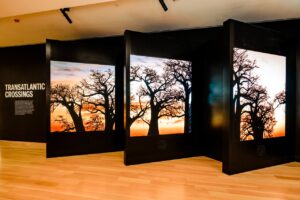
Transatlantic Experience | Transatlantic Experience Exhibit
The Transatlantic Experience provides visitors with a large-scale immersive media experience. Situated as the entry point to the east wing of IAAM, this experience features eight large video screens, which take visitors on a historical journey through hundreds of years of history, from African cultural roots to the tragedy of the Middle Passage and into local and international diaspora scenes and traditions. The four-minute film offers an introductory experience to the themes, emotions, and historical interpretations that visitors will encounter throughout their museum experience.
The Theater Gallery | Film Exhibit
The Theater Gallery, adjacent to the Transatlantic Experience, features films and videos, which provide broad historical context and further orient the visitor to the overall museum experience through a narrative storytelling format. The original film to be featured in this gallery will be produced and co-conceived by the award-winning film collective The Ummah Chroma.
Gullah Geechee Gallery | Gullah Geechee Exhibit
With a focus on the Lowcountry of South Carolina and Georgia, the Gullah Geechee Gallery provides an introduction to Gullah Geechee history and culture. Through the exploration of themes including activism, organization, and cultural practices and preservation, this gallery examines the history of the community as well as contemporary issues facing Gullah Geechee communities. Featuring a full-size bateau (boat), a recreated praise house, and multiple media experiences, the Gullah Geechee Gallery provides insight into the dynamic cultural identity of the Gullah Geechee people and endeavors to define and demystify what it means to be Gullah Geechee.
South Carolina Connections Gallery | South Carolina Connections Exhibit
The South Carolina Connections Gallery focuses on African American and African diasporic history that is within and historically interconnected to South Carolina. Featuring key artifacts and an interactive map table powered by Google, the South Carolina Connections Gallery provides insight into known and lesser-known South Carolinians, as well as relevant places and events from early colonial settlement to the present. This gallery tells stories of resistance and achievement, from the many local, national, and international influential African Americans in South Carolina’s history. Significant artifacts in this gallery include tennis rackets belonging to Althea Gibson, the first African American tennis player to compete at the U.S. National Championships, as well as a Waterford Crystal Award, commemorating her Wimbledon singles and doubles championship wins in 1957.
African Roots Gallery | African Roots & African Routes Exhibits
The African Roots Exhibit explores the diverse empires, cultures, historic figures, knowledge systems, and technologies of West and West Central Africa — the areas of origin connected to Africans forced to the Americas. A central media program highlights the dynamic past, present, and future of these regions, and Africa more broadly, from empires and societies to colonies and modern nations. Key artifacts in this exhibit include an 18th century Islamic astrolabe, as well as masks, currency, and jewelry from different West and West Central African ethnolinguistic groups.
The African Routes: Diaspora in the Atlantic World Exhibit illuminates stories that exemplify the influence and movement of people of African descent throughout the Atlantic World over time, from the Transatlantic slave trade to the 21st century. Layered against a collage of images that illustrate the vast breadth and diversity of the African diaspora in the Atlantic World, stories are organized by themes of intellectual connections, spirituality, and cultural expressions presented through a dynamic media program.
Atlantic Worlds Gallery | Atlantic Worlds Exhibit
The Atlantic Worlds Gallery explores the nuanced historical connections throughout the Black Atlantic World. Focusing on the major themes of resistance, revolution, creolization, immigration, and the Middle Passage, this gallery explores the deep interconnectivity between Africa, the Americas, and Europe. A 30-foot, ultra-high-definition video screen on the South wall of the gallery features an original short film that examines the historical connections between Charleston, Barbados, and Sierra Leone. The floor space of the gallery is filled with both historical and contemporary objects, art, and artifacts from throughout the Black Atlantic World.
Carolina Gold Gallery | Carolina Gold & Memories of the Enslaved Exhibits
By examining the roots of the plantation system, the skills and knowledge of Africans from rice growing regions of Africa, and how enslaved Africans and their descendants created community, kinship, and cultivated resistance, the Carolina Gold Exhibit demonstrates the transformative impact of enslaved people who labored on plantations in South Carolina and helped build the lucrative rice industry. A media program describes the knowledge and labor of enslaved people on the rice plantations, illustrating how enslaved West Africans brought significant knowledge and technological contributions to rice cultivation in the region, while also describing the physical and emotional toll it took on those working in tidal rice-growing regions in South Carolina.
The Memories of the Enslaved Exhibit utilizes quotes and insight of formally enslaved people to examine the brutality of chattel slavery. The lived experiences of these men and women demonstrate the importance of memory, violence, family, and culture. Featuring original artifacts including a jug made by enslaved potter Dave “The Potter” Drake and Ashley’s Sack, this exhibit illustrates how remembrance of enslavement was passed down intergenerationally within African American families. The media program in this gallery encourages visitors to form an emotional connection with formerly enslaved people by hearing their stories, their words, and their voices.
American Journeys Gallery | American Journeys Exhibit
The American Journeys Gallery presents key moments, figures, and movements in African American history that are interconnected with South Carolina, showing how they shaped, and were shaped, by local, national, and international cultures, politics, and economies. This gallery is organized into twelve chronological sections: Carolina in the Atlantic World; the Rise of Plantation Slavery; Revolutions; Expanding the United States; Emancipation to Reconstruction; the Return of the Old Order; Color Lines; Mobility, Migrations, and Military Service; South Carolina’s Freedom Struggle; Global Human Rights; Revolts and Transformations; and Movements. Significant artifacts in the gallery include the “Come and Join Us Brothers” lithograph, published by the Supervisory Committee for Recruiting Colored Regiments, Cir. 1863; a uniform from Company E, 24th U.S. Infantry Buffalo Soldier regiment formed in 1869; one of two American flags flown over the United States Capitol on April 4, 2018, in remembrance of the 50th anniversary of Dr. Martin Luther King Jr.’s assassination in Memphis, Tennessee; along with various items connected to the Civil Rights and Black Power Movements, both locally and nationally.
Special Exhibitions Gallery
The Special Exhibitions Gallery is a 3000 sq ft. space dedicated to temporary, rotating exhibits. This gallery features a variety of historical, artistic, and immersive exhibits, which expand on the core exhibits. These include traveling shows curated by other institutions, as well as shows originated by IAAM. The first rotating exhibit produced by IAAM will be titled Follow the North Star. Sponsored by Michelin, this exhibit will explore the literal and figurative theme of mobility throughout African American history.
Creative Journeys Exhibit
The Creative Journeys Exhibit consists of artwork, poems, films, and creative materials placed throughout IAAM. These works of art on walls, pedestals, and screens exist in conversation with the historical content of each gallery and provide alternative vantage points for understanding history and the role that creative expression plays in both shaping and reflecting its arc. Existing in sections throughout each gallery, rather than in a dedicated gallery of its own, the Creative Journeys Exhibit features works that are connected visually through color branding, as well as thematically through curatorial text primarily displayed within the American Journeys Gallery.
Digital Exhibits
IAAM utilizes the Google Arts & Culture platform to develop and publish digital exhibits which explore themes and special topics relevant to the museum’s mission. These exhibits feature film, photography, interactive media, and historical interpretation that go beyond the stories and themes explored within the core exhibits in the building. With more stories and historically significant events that could ever fit in a single building, IAAM’s Digital Exhibits platform allows the museum to significantly expand its breadth and reach. In addition to these digital exhibits, the museum’s core collection and physical exhibits will be digitized and made available online.
LEADERSHIP
Tonya M. Matthews, PhD
President and Chief Executive Officer (CEO)
Dr. Tonya M. Matthews is a thought-leader in institutionalized equity and inclusion frameworks, social entrepreneurship, and the intersectionality of formal and informal education. Her background as both poet and engineer have made her a highly sought-after visioning partner on boards and community building projects, as well as a frequent public speaker and presenter for communities across all ages and venues.
John Anderson
Vice President of Administration and Chief Operating Officer (COO)
Anderson joined the International African American Museum in 2021 as vice president and COO. In this role, he is responsible for activating the museum’s visitor experiences, building and site operations, organizational administration, and company culture. Prior to joining IAAM, Anderson served as the Michigan Science Center’s vice president of administration and chief operating officer. Prior to that, he held multiple professional positions with the City of Detroit and Detroit Zoological Society.
Dianne Firment
Chief Financial Officer (CFO)
Firment joined the International African American Museum in 2019 as director of finance and was promoted to CFO in 2021. In this role she is responsible for propelling the financial growth and success of the museum’s operations.
Malika N. Pryor
Chief Learning and Education Officer
Malika N. Pryor, chief learning and engagement officer for the International African American Museum, provides strategic direction for creating and enhancing dynamic programs that explore the Middle Passage, the African diaspora, and the crucial contributions that African Americans have made to our history and to our modern world. As a member of the senior executive team, Pryor works closely with the CEO to establish partnerships and programs that support and sustain the museum’s mission, including exhibitions, school programs, faith-based initiatives and programs, local and national public programs, and the Center for Family History, a one-of-a-kind
research center that focuses on African American genealogy.

For more information, please visit www.iaamuseum.org or call 843-872-5352.

Pierre A. Evans is a freelance writer of Entertainment, Music, Art, Culture, Fashion and Current Events, and previously for SoulTrain.com, NDigo.com, ChicagoDefender.com, EmpireRadioMagazine.com, and UrbanMuseMag.com, an author, singer/songwriter, actor, model, poet, dancer, and DJ. He is also the Owner of Pinnacle Entertainment Productions and the Owner/Publisher of GO BANG! Magazine. Follow him on Facebook @Pierre Andre Evans, Twitter @Playerre, and on Instagram @Pierre_Andre_Evans.






